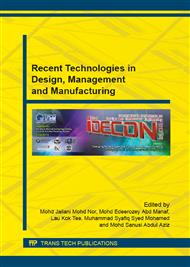p.267
p.273
p.277
p.282
p.287
p.293
p.298
p.303
p.308
Multi Objective Optimization of Cutting Parameters in Machining Cellulose Based Hybrid Composites
Abstract:
Cellulose based hybrid composites are gaining popularity in the growing green communities. With extensive studies and increasing applications for future advancement, the need for an accurate and reliable guidance in machining this type of composites has increased enormously. Smooth and defect free machined surface are always the ultimate objectives. The present work deals with the study of machining parameters (i.e. spindle speed, feed rate and depth of cut) and their effects on machining performance (i.e. surface roughness and delamination) to establish an optimized setup of machining parameters in achieving multi objective machining performance. Cellulose based hybrid composites consist of jute (a bast fiber) and glass fiber embedded in polyester resins. Response Surface Methodology (RSM) using Box-Behnken Design (BBD) was chosen as the design of experiment approach for this study. Based on that experimental approach, 17 experimental runs were conducted. Mathematical model for each response was developed based on the experimental data. Adequacy of the models were analyzed statistically using Analysis of Variance (ANOVA) in determining the significant input variables and possible interactions. The multi objective optimization was performed through numerical optimization, and the predicted results were validated. The agreement between the experimental and selected solution was found to be strong, between 95% to 96%, thus validating the solution as the optimal machining condition. The findings suggest that feed rate was the main factor affecting surface roughness and delamination .
Info:
Periodical:
Pages:
287-292
Citation:
Online since:
May 2015
Authors:
Price:
Сopyright:
© 2015 Trans Tech Publications Ltd. All Rights Reserved
Share:
Citation:


